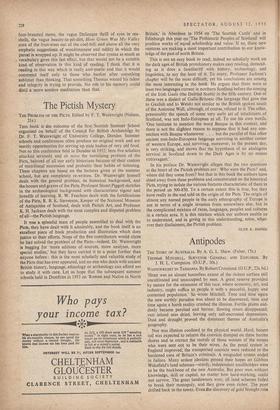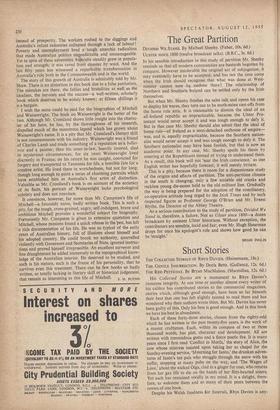Antipodes
THE STORY OF AUSTRALIA. By A. G. L. Shaw. (Faber, 15s.)
WAINEwRIGHT IN TASMANIA. By Robert Crossland. (O.U.P., 22s. 6d.) 'HERE was an almost boundless extent of the richest surface still uncultivated and unoccupied by men. A great reserve provided by nature for the extension of this race, where economy, art, and industry, might suffice to people it with a peaceful, happy and contented population.' So wrote Mitchell. Time and time again the new earthly paradise was about to be discovered; time and time again, a harsh reality crushed the illusion. Fertile plains sud- denly became parched and barren; flowing rivers disappeared; vast inland seas dried, leaving only salt-encrusted depressions. Dust and drought proved the dominant themes of Australia's, geography.
Nor was illusion confined to the physical world. Hard, honest toil was expected to reform the convicts dumped on these barren shores and to correct the morals of those women of the streets who were sent out to be their wives. As the penal system in England improved, the transported convicts were reduced to the hardened core of Britain's criminals. A misguided system ended in failure. Many ardent idealists pinned their hopes on Gibbon Wakefield's land schemes—sturdy, independent smallholders were to be the backbone of the new Australia. But poor men without knowledge, skill or capital, no matter how hard-working, could not survive. The great landowners won; all land schemes failed to break their monopoly, and they grew even richer. The poor drifted back to the towns. Even the discovery of gold brought ruin instead of prosperity. The workers rushed to the diggings and Australia's infant industries collapsed through a lack of labour! Poverty and unemployment bred a tough anarchic radicalism that made Australian politics unpredictable and unmanageable. Yet in spite of these adversities Australia steadily grew in popula- tion and strength; it was saved from disaster by wool. And the last fifty years has witnessed a remarkable transformation in Australia's role both in the Commonwealth and in the world.
The story of this growth of Australia is admirably told by Mr. Shaw. There is no distortion in this book due to a false patriotism. The mistakes are there; the follies and brutalities as well as the idealism, the heroism and the success—a well-written, scholarly book which deserves to be widely known : at fifteen shillings it is a bargain.
I wish the same could be said for the biographies of Mitchell and Wainewright. The book on Wainewright is the better of the two. Although Mr. Crossland shows little insight into the charac- ter of his hero, he has, by the thoroughness of his research, dispelled much of the monstrous legend which has grown about Wainewright's name. It is a pity that Mr. Crossland's literary skill is not commensurate with his industry. Wainewright was a friend of Charles Lamb and made something of a reputation as a bellet- trist and a painter; then his sister-in-law, heavily insured, died in mysterious circumstances; for six years Wainewright lived discreetly in France; on his return he was caught, convicted for forgery and transported to Tasmania for life, a horrible fate for a creative artist. He lived there in wretchedness, but not for long; though long enough to paint a series of charming portraits which have established him as Australia's first artist of distinction. Valuable as Mr. Crossland's book is on account of the accuracy of its facts, his portrait of Wainewright lacks psychological subtlety and does not convince.
It convinces, however, far more than Mr. Cumpston's life of Mitchell—a fatuously naive, badly written book. This is such a pity, for the tough, cross-grained, angry, self-indulgent, brave and ambitious Mitchell provides a wonderful subject for biography. Fortunately Mr. Cumpston is given to extensive quotation and Mitchell, whose passions found a quick rdlease in the'pen, has left a rich documentation of his life. He was so typical of the early years of Australian history, full of illusions about himself and his adopted country. He could brook no authority, quarrelled violently with Governors and Secretaries of State, ignored instruc- tions and proved himself irrepressible. An excellent surveyor and fine draughtsman he added immensely to the topographical know- ledge of the Australian interior. He deserved to be studied, and such is his stature, such is the frame of his personality, that he survives even this treatment. There can be few books so badly written, so totally lacking in literary skill or historical judgement, that remain as interesting as this life of Mitchell. J. H. PLUMB



































 Previous page
Previous page